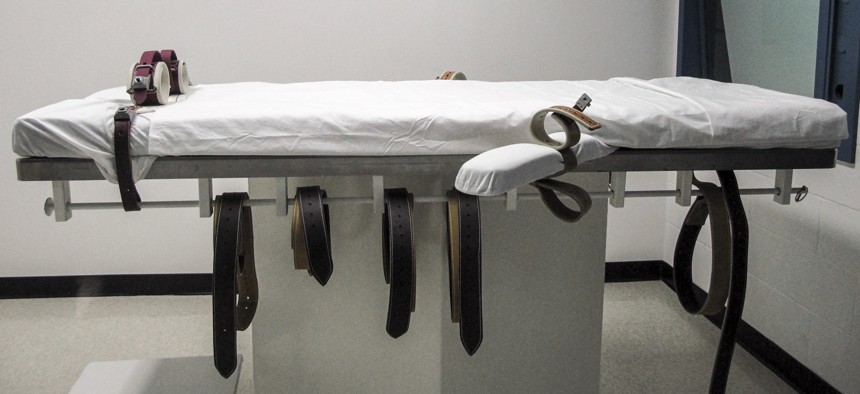Death Penalty Used by an Increasingly Small Number of States

This July 7, 2010 file photo, shows Nebraska's lethal injection chamber at the State Penitentiary in Lincoln, Neb. AP Photo/Nate Jenkins

Connecting state and local government leaders
Seven states executed 22 inmates this year, the second lowest number of executions since 1991.
The number of death sentences handed down and executions carried out across the United States remained near historic lows in 2019, with use of capital punishment restricted to an increasingly isolated number of states, according to a new report.
Seven states executed 22 inmates this year—the second fewest number of executions in 28 years, according to the Death Penalty Information Center’s annual report on use of capital punishment. That’s down from 25 executions carried out in eight states in 2018.
Executions were primarily concentrated in southern states, with Texas leading the nation with nine prisoners executed this year. Texas was followed by Tennessee, Alabama and Georgia, which each carried out three death sentences.The total number of executions carried out in the United States peaked in 1999, when 98 inmates were executed. Capital punishment has generally been on the decline since then.

Difficulty procuring the drugs used for lethal injection, concerns over the possibility of wrongly convicted people being executed, and gruesome stories about botched executions have all fed into states officials’ concerns with continued use of capital punishment.
Citing these concerns, a number of states have acted in recent years to abolish or restrict use of capital punishment. This year, New Hampshire became the 21st state to abolish the death penalty. California, which has the largest number of prisoners on death row, joined Oregon, Washington and Colorado in establishing a governor-issued death penalty moratorium.
“With those actions, half of all U.S. states have abolished the death penalty or now prohibit executions, and no state in New England authorizes capital punishment at all,” the DPIC report said.
In addition to doing away with the death penalty, states have taken other steps to limit its use.
Oregon, which has a moratorium on executions, restricted the number of death-penalty eligible crimes from 19 to four. Death penalty-eligible aggravated murder is now limited to those convicted of acts of terrorism that kill two or more people; premeditated murder of a child under the age of 14; murder of another person while locked up in jail or prison for a previous murder; or murder of a law enforcement officer.
Arizona similarly reduced the number of aggravating factors that would make a crime punishable by death from 14 to 11.
A near-record low number of death sentences are also expected to be handed down this year. Across the country, juries or judges had sentenced 33 defendants to death as of Tuesday, but the DPIC is tracking an additional three cases which could result in the death penalty. The center projects that death sentences will be down more than 10% from the 43 sentences imposed in 2018.
Death sentences were most frequently handed down in Florida and Ohio, where six people in each state were sentenced to death.
Since the Supreme Court reaffirmed the legality of the death penalty in 1976, more than 1,500 people have been executed in the United States.
While states moved away from capital punishment, the federal government has sought to revive federal executions after a 16-year hiatus. Attorney General William Barr asked the Justice Department to schedule executions of five federal inmates who were each found guilty of murder. But each of the executions has been placed on hold following intervention from the Supreme Court.

NEXT STORY: The Right to Eviction Counsel Is Gaining Momentum




